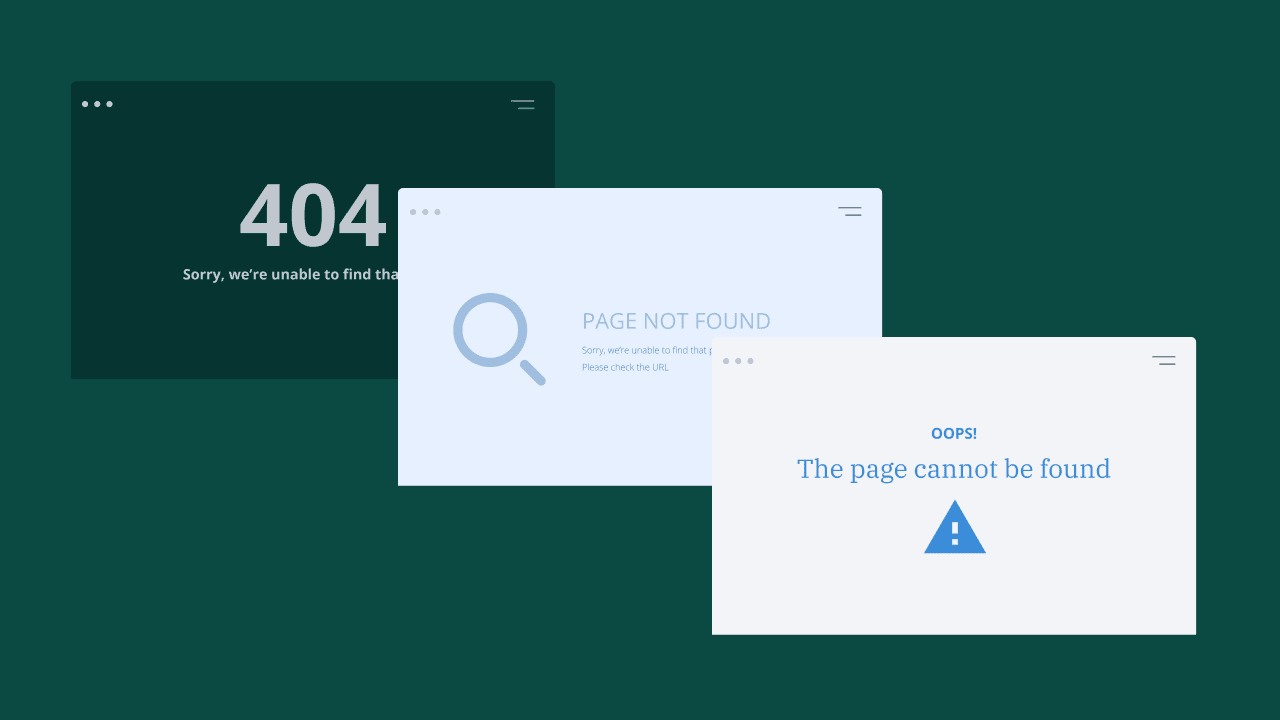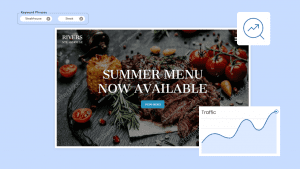Key takeaways:
- A 404 page can either frustrate users or guide them back into your site; thoughtful design makes the difference.
- Great 404 pages balance branding, usability, and creativity, as shown by examples from Mailchimp, Pixar, Marvel, and 9GAG.
- Avoid common mistakes like generic error text, cluttered layouts, or ignoring mobile users and analytics.
Few things frustrate visitors more than landing on a dead end. They click a link expecting useful information. Instead, they see the dreaded “404 Page Not Found.” In that moment, trust wavers. Patience thins. Many users leave your site altogether.
Studies back this up. 88% of online consumers are less likely to return after a poor experience. And over 61% leave websites with confusing navigation. That makes clear error messaging and smart 404 page design even more important.
The problem isn’t just the error itself. It’s how the page responds. A bland, generic message signals neglect. Worse, it can hurt SEO, raise bounce rates, and weaken your brand’s credibility.
But here’s the good news. A 404 page doesn’t have to be a setback. With the right design, it can guide visitors back on track.
In this blog, we’ll cover why 404 pages matter, how to design one that helps users, best practices, real examples, and common mistakes to avoid.
Why 404 pages are important for your website
A 404 page is more than an error message. It plays a dual role in shaping how users interact with your site and how search engines evaluate it.
- For users. A clear, helpful 404 page reduces frustration and offers a way forward. Instead of leaving, visitors can continue exploring your site. This keeps them engaged and less likely to turn to a competitor.
- For SEO. Search engines track how visitors behave when they hit an error. A high bounce rate can hurt rankings. But a well-designed 404 page with internal links helps crawlers understand your site, preserve link equity, and improve crawlability.
If your 404 page is poorly designed, the opposite happens:
- Visitors feel stuck and leave.
- Bounce rates rise.
- Your brand looks unprofessional.
If you’re not familiar with what this error means, here’s a deeper look at what a 404 error is.
How to design a 404 page that actually helps users
A 404 page should never feel like a dead end. The goal is to reduce frustration, guide visitors back on track, and keep your brand credibility intact.
Here are design best practices to follow:
- Keep it clear and effortless
- Stay on brand, even in errors
- A dash of humor (with caution)
- Always give users a way forward
- Fast and frustration-free
For a more detailed description with examples, let’s get started.
1. Keep it clear and effortless
Visitors shouldn’t have to think twice about an error page. Avoid clutter and guide them quickly to their next step. For example, PayPal’s 404 page keeps navigation visible at the top, making it easy for users to find their way back without scrolling or guessing.

On the other hand, YouTube takes a lighter approach with a simple search bar and a playful graphic. It’s clear, fast, and still keeps the experience on brand.

Both designs show that clarity and ease of use should come first. When users instantly understand what went wrong and where to go next, they’re far less likely to abandon the site.
2. Stay on brand, even in errors
Your 404 page should still feel like part of your site. Use your logo, colors, and style so visitors know they’re in the right place. LEGO does this well with a playful 404 page featuring a recognizable LEGO character and humorous messaging. It keeps the tone fun while guiding users back to the homepage with a clear call-to-action button.
It’s on-brand and helpful.

3. A dash of humor (with caution)
A clever line or fun visual can make a 404 page more memorable. IMDB strikes the right balance by using rotating movie quotes that add personality without confusing visitors.
The message remains clear that it’s an error page, but the pop culture touch keeps the experience engaging and on-brand.

4. Always give users a way forward
Every 404 should include navigation options. Add a clear homepage button, product or service links, or even a site search. That way, users can recover quickly and continue engaging with your content.
5. Fast and frustration-free
A slow-loading 404 only adds to the problem. Keep graphics lightweight, avoid overloading animations, and make sure the page loads instantly.
These best practices transform a 404 page from a dead end into a seamless, branded touchpoint that keeps visitors engaged and exploring your site.
Want more ideas on how strong design can shape user experience? Take a look at our video on Professional Website Design by Network Solutions.
404 page examples you can learn from
Looking at real-world 404 designs is one of the best ways to spark ideas for your own site. These five examples stand out for how they balance creativity, brand personality, and usability:
- Mailchimp
- Pixar
- Marvel
- 9Gag
Read on to see why these brands are on the list.
1. Mailchimp – Simple and playful
Mailchimp’s 404 error page is lighthearted but effective. A fun illustration matches the brand’s tone while a clear message explains the error. The clean design keeps the focus on helping visitors move forward without confusion.

2. Pixar – On-brand storytelling
Pixar features Ennui from Inside Out 2 to deliver the 404 error page message in a way that fits their storytelling style. The clean layout with ample white space makes the page feel thoughtful and easy to navigate, creating an emotional yet straightforward user experience.

3. Marvel – Heroes meet mystery
Marvel leans into its comic book storytelling with a visually striking 404 page. In this version, Black Widow appears alongside a witty message: “Not even the Eye of Uatu sees your request…” It’s a playful nod to Marvel’s lore that keeps fans engaged while still offering practical guidance to check the URL, go back, or use the site search.

4. 9GAG – Humor with a hook
9GAG leans into its trademark humor with a funny background meme, instantly lightening the mood of a broken page. The large “404” text is clear, and beneath it, a call-to-action encourages visitors to download the app. It’s a clever way to keep users connected with the brand even after running into an error.

These examples highlight that there’s no single formula for a great 404 page. The best designs reflect each brand’s personality while keeping the experience simple, helpful, and user-focused.
Common mistakes to avoid with 404 page design
Even the most polished websites can stumble if their 404 page is handled poorly. Instead of helping visitors recover, these mistakes push them away and damage trust. Knowing what not to do is just as important as following best practices.
Here are the most common mistakes businesses make:
- Using a generic “page not found” message
- Overloading the page with clutter
- Forgetting mobile users
- Ignoring analytics and tracking
- Using a generic “page not found” message
A plain error message without context or links frustrates users instantly. It offers no path forward and signals that the brand hasn’t put effort into helping them. This often results in visitors bouncing to a competitor’s site. A simple call-to-action or homepage button can make all the difference.
2. Overloading the page with clutter
Some sites go too far the other way by adding unnecessary text, busy graphics, or long explanations. Instead of helping, this creates confusion. A 404 page works best when it’s clean, focused, and designed around a single goal: quickly getting the user back on track.
3. Forgetting mobile users
More than half of web traffic today comes from mobile devices. If your 404 page isn’t responsive, visitors on smaller screens may struggle with tiny buttons, broken layouts, or slow load times. A mobile-optimized design ensures the error page is just as easy to use as the rest of your site.
4. Ignoring analytics and tracking
One of the biggest missed opportunities is failing to track how often visitors encounter 404s and where they come from. You can’t fix broken links or improve the experience without this data. Tools like Google Analytics or Search Console can flag high-traffic errors, helping you patch issues and refine your design.
Build a smarter 404 experience
A 404 page is never just an error screen. It is a moment of frustration that can either push visitors away or pull them back in. With thoughtful design, you can guide people forward, keep your brand consistent, and protect your site’s performance.
Now is the time to take a closer look at your own 404 page. Does it carry your brand’s voice? Does it give visitors a reason to stay? Even small updates such as clear messaging, simple navigation, and faster load times can change the experience completely.
Don’t leave this page to chance. With Network Solutions, you can build a site where every detail matters. From custom web design to hosting and domain management, our services make sure that every page, including your 404, works to keep visitors engaged.
Frequently asked questions
Start with a friendly message that explains the issue. Make sure the page looks consistent with your brand and gives visitors clear options such as a homepage button, product links, or a search bar.
A successful 404 page keeps people from leaving. It explains what went wrong, reflects your brand style, and points visitors toward useful next steps.
Most website platforms, including WordPress and Squarespace, let you replace the default error screen with your own design. You can add branded visuals, helpful links, and navigation so users stay connected to your site.
In Next.js, you can add a 404.js file inside the pages folder to replace the default error page. Use this file to design your own layout with your brand elements, message, and navigation options.




